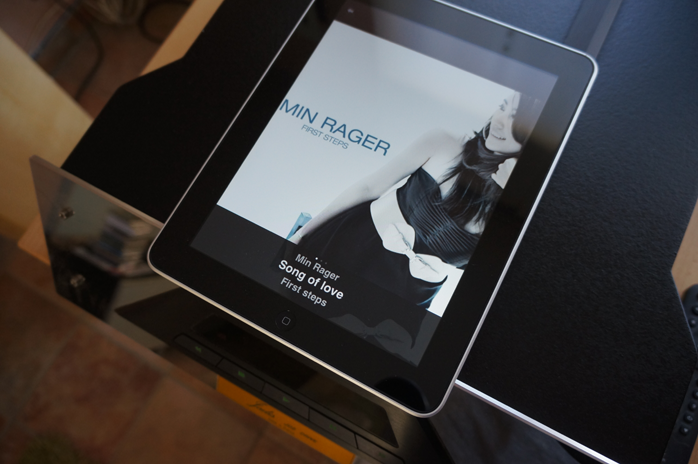This review page is supported in part by the sponsors whose ad banners are displayed below |
 |
 |
|
 |
Reviewer: Joël Chevassus
Financial Interests: click here
Source: Apple iMac, Squeezebox Touch + Welborne Labs PSU, Jadis JD-2 Drive, Audio GD Ref 5, Totaldac, Trends UD-10.1, Wyred4Sound Music Server [on review], Wyred4Sound DAC 2 [on loan], MacBook Lion OSX with HiFace USB-to-S/PDIF interface, iMac Lion OSX
Amp/Preamp: Rogue Audio Hera II, Wyred4Sound STP-SE, SPL Volume2, Orpheus Lab Three M, Trends TA-10.2
Speakers: Triangle Magellan Duetto, Sonus faber Guarneri Evolution [on loan]
Cables: Legato digital cable, Skywire Audio 2020 digital cable, Naturelle Audio interconnects Live 8 MK2, Audio Art SC-5 SE speaker cables, Legato Precision speaker cables, Legato Fluidita interconnects
Power cords: Audio Art Power 1 SE, Furutech and Legato power cords
Stands & room: DIY stuff, Triangle TS400 stands, Vicoustic panels
Review components retail: $2.499 for 2TB server, $199 for I²S cable 0.5m
|
 |
Context. Wyred4Sound’s release of its first digital drive shows zero interest going through the intermediary stage of legacy CD spinners. EJ Sarmento focused directly on a server which, as usual for the brand, had to deliver high performance for a good price. Considering the many contenders that have grown up around the audio server segment proposing solutions at all price points, there certainly was room for another Californian exploit. Despite being a relatively recent niche market, the audio server segment already makes up a wide range of products from extremely cheap mass productions to more conventional audiophile products including very ambitious expensive solutions made by perfect strangers and a few more familiar names.
|
 |
It is indeed an extremely heterogeneous sphere where small competitors like Olive or Wideleab play against giants like Apple and Logitech. These actors certainly don’t entertain the same expectations nor target the same market segment. They obviously also don’t compete with the same weapons at hand. But since it is particularly complex to combine ergonomics, simplicity of use, compactness, sound performance and versatility within the same unique product, let’s say for the moment that there’s room for everyone. Because audiophile expectations may vary from one prospective buyer to another, it is important to detail precisely what my personal references and expectations were about such modern digital playback.
|
|
|
When I decided that my mushrooming CD collection had become too unruly to manage, I decided to keep only one digital CD drive as reference and serious benchmark for any computer-based replacement solution which I might eventually end up with. My most important criterion for a PCfi source was fast access to my entire music library without sacrificing sonics. In short, convenience with sound almost equal to or better than from my dedicated CD drive.
Theoretically this was an easy goal. In reality it is more elusive. All the simplicity of use of my Jadis drive or previous Audio Analogue Grand Maestro were lost in a jungle of formats, player appliances, jitter and tagging issues. For the last 20 years interfacing with a CD player had become quite easy compared to past vinyl setup routines. Now far greater complexities with the audiophile computer concept introduced a steep new learning curve.
|
 |
The Jadis JD-2 happens to deliver a very analogue liquid sound with a profusion of detail and high quality of timbre. It’s an every-day reminder that a drive makes a big difference in the digital domain and that not all is as it should be with the ‘bit-perfect’ concept. I fell in love with the Jadis JD-2 two years ago and was very pleased to obtain a second-hand unit for a decent price that was in my opinion the positive summation of all Metronome Technologie products with a more liquid involving character added. It seems that one part of the difference—Jadis used to subcontract its CD players to Metronome—was linked to the different suspension of the Philips CDM Pro. Metronome's drives are spiked it whilst Jadis used springs. In my opinion Jadis remains an outside performer in the Redbook playback field and the recent release of their €29.000 Calliope drive perhaps illustrates their level of expectations in the digital domain.
|
|
|
|
But it’s not my purpose to compare products as disparate as my 10-year old Jadis drive and the year 2012 Wyred4Sound Music Server. It simply sets up my personal expectations for digital playback. When switching to dematerialised mode, ergonomics and simplicity of use are vital features. I find a computer anything but relaxing. I use it at work every day, at home for writing commitments and sometimes also to run family affairs. When I relax, the last things I want are a flat screen, keyboard and motherboard with various networking and software issues. Add to that my old-fashioned character and you will have a good hunch of what I mean by ergonomics and simplicity of use.
|
 |
My first successful experience in the field of dematerialised music with my personal requirements for ergonomics and simplicity fulfilled came at the hands of the ex Slimdevices (now Logitech) Squeezebox. This streamer was and remains a good compromise between ergonomics and sonics. I don’t consider the current Squeezebox Touch a genuine high-end player but in a good setup with a decent host to run the Squeezebox server, some additional tweaks and soft modifications provided by blogger Klaus plus a good D/A converter, it can be considered a very satisfying source even in the best of systems.
|
 |
 |
 |
|